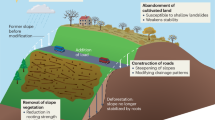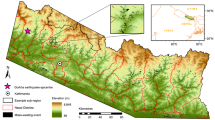Abstract
Major earthquakes cause widespread environmental and socioeconomic disruptions that persist for decades. Extensive ground disturbances that occurred during the shallow-focus Kumamoto earthquakes will affect future sustainability of ecosystem services west of Aso volcano. Numbers of earthquake-initiated landslides per unit area were higher in grasslands than forests, likely owing to greater root reinforcement of trees, and mostly initiated on ridgelines and/or convex/planar hillslopes. Most landslides traveled short distances and did not initially evolve into debris flows; resultant sediments and wood accumulating in headwater channels can be mobilized into debris flows during future storms. Fissures along ridgelines may promote water ingress and induce future landslides and debris flows that affect residents downstream. Native grasses are at risk because of habitat fragmentation caused by ground disturbances, extensive damage to rural roads, and abandonment of traditional pasture management practices. Sustainable management of affected areas needs to consider future risk of cascading hazards and long-term socioeconomic impacts.








Similar content being viewed by others
References
Adams, P.W., and R.C. Sidle. 1987. Soil conditions in three recent landslides in southeast Alaska. Forest Ecology and Management 18: 93–102.
Adger, W.N. 2000. Social and ecological resilience: Are they related? Progress in Human Geography 24: 347–364.
Ágústsdóttir, A.M. 2015. Ecosystem approach for natural hazard mitigation of volcanic tephra in Iceland: Building resilience and sustainability. Natural Hazards 78: 1669–1691.
Atwater, B.F., D.K. Yamaguchi, S. Bondevik, W.A. Barnhardt, L.J. Amidon, B.E. Benson, G. Skjerdal, J.A. Shulene, et al. 2001. Rapid resetting of an estuarine recorder of the 1964 Alaska earthquake. Geological Society of America Bulletin 113: 1193–1204.
Bergeron, Y., D. Cyr, C.R. Drever, M. Flannigan, S. Gauthier, D. Kneeshaw, È. Lauzon, A. Leduc, H.L. Goff, and D. Lesieur. 2006. Past, current, and future fire frequencies in Quebec’s commercial forests: Implications for the cumulative effects of harvesting and fire on age-class structure and natural disturbance-based management. Canadian Journal of Forest Research 36: 2737–2744.
Buma, B., R.E. Poore, and C.A. Wessman. 2014. Disturbances, their interactions, and cumulative effects on carbon and charcoal stocks in a forested ecosystem. Ecosystems 17: 947–959.
Castilla, J.C. 1988. Earthquake-caused coastal uplift and its effects on rocky intertidal kelp communities. Science 242: 440–443.
Center, Asian Disaster Reduction. 2016. 2016 kumamoto earthquake survey report (Preliminary). Kobe: Asian Disaster Reduction Center.
Cramer, V.A., R.J. Hobbs, and R.J. Standish. 2008. What’s new about old fields? Land abandonment and ecosystem assembly. Trends in Ecology & Evolution 23: 104–112.
Cutter, S.L., L. Barnes, M. Berry, C. Burton, E. Evans, E. Tate, and J. Webb. 2008. A place-based model for understanding community resilience to natural disasters. Global Environmental Change 18: 598–606.
Deligne, N.I., K.V. Cashman, and J.J. Roering. 2013. After the lava flow: The importance of external soil sources for plant colonization of recent lava flows in the central Oregon Cascades, USA. Geomorphology 202: 15–32.
Fang, Y.-P., C. Zhao, Y.-J. Ding, D.-H. Qin, and J.-L. Huang. 2016. Impacts of snow disaster on meat production and adaptation: An empirical analysis in the yellow river source region. Sustainability Science 11: 249–260.
Folke, C. 2006. Resilience: The emergence of a perspective for social–ecological systems analyses. Global Environmental Change 16: 253–267.
Folke, C., S. Carpenter, B. Walker, M. Scheffer, T. Chapin, and J. Rockström. 2010. Resilience thinking: Integrating resilience, adaptability and transformability. Ecology and Society 15: 20.
Goda, K., G. Campbell, L. Hulme, B. Ismael, L. Ke, R. Marsh, P. Sammonds, E. So, Y. Okumura, and N. Kishi. 2016. The 2016 Kumamoto earthquakes: Cascading geological hazards and compounding risks. Frontiers in Built Environment 2: 19.
Gunderson, L. 2010. Ecological and human community resilience in response to natural disasters. Ecology and Society 15: 18.
Japan Meteorological Agency. 2016. Climate change monitoring report 2015. Japan: Tokyo.
Kato, H., Y. Onda, and T. Gomi. 2012. Interception of the Fukushima reactor accident-derived 137Cs, 134Cs and 131I by coniferous forest canopies. Geophysical Research Letters 39: L20403.
Kawase, H., S. Matsushima, F. Nagashima, and K. Nakano. 2017. The cause of heavy damage concentration in downtown Mashiki inferred from observed data and field survey of the 2016 Kumamoto earthquake. Earth, Planets and Space 69: 3.
Knight, J., and J.R. Goff. 2016. Coastal science for post-tsunami reconstruction. The Holocene 26: 1334–1340.
Kobayashi, S., T. Gomi, R.C. Sidle, and J.N. Negishi. 2013. Distribution of amphipods (Gammarus nipponensis Ueno) among mountain headwater streams with different legacies of debris flow occurrence. Ecohydrology 6: 117–124.
Koi, T., N. Hotta, I. Ishigaki, N. Matuzaki, Y. Uchiyama, and M. Suzuki. 2008. Prolonged impact of earthquake-induced landslides on sediment yield in a mountain watershed: The Tanzawa region, Japan. Geomorphology 101: 692–702.
Koyama, A., T.F. Koyanagi, M. Akasaka, M. Takada, and K. Okabe. 2017. Combined burning and mowing for restoration of abandoned semi-natural grasslands. Applied Vegetation Science 20: 40–49.
Koyanagi, T.F., M. Akasaka, H. Oguma, and H. Ise. 2017. Evaluating the local habitat history deepens the understanding of the extinction debt for endangered plant species in semi-natural grasslands. Plant Ecology 218: 725–735.
Lenton, T.M., H. Held, E. Kriegler, J.W. Hall, W. Lucht, S. Rahmstorf, and H.J. Schellnhuber. 2008. Tipping elements in the Earth’s climate system. Proceedings of the National Academy of Sciences 105: 1786–1793.
Liao, K.-H. 2014. From flood control to flood adaptation: A case study on the Lower Green River Valley and the City of Kent in King County, Washington. Natural Hazards 71: 723–750.
Lim Mangada, L. 2016. Post-Haiyan adaptation and institutional barriers to women survivors in Tacloban. Philippine Political Science Journal 37: 94–110.
Lin, C.-W., S.-H. Liu, S.-Y. Lee, and C.-C. Liu. 2006a. Impacts of the Chi-Chi earthquake on subsequent rainfall-induced landslides in central Taiwan. Engineering Geology 86: 87–101.
Lin, Y.-P., T.-K. Chang, C.-F. Wu, T.-C. Chiang, and S.-H. Lin. 2006b. Assessing impacts of typhoons and the Chi-Chi earthquake on Chenyulan watershed landscape pattern in Central Taiwan using landscape metrics. Environmental Management 38: 108–125.
Manyena, S.B. 2006. The concept of resilience revisited. Disasters 30: 434–450.
Marden, M., and D. Rowan. 1993. Protective value of vegetation on tertiary terrain before and during Cyclone Bola, East Coast, North Island, New Zealand. New Zealand Journal of Forestry Science 23: 255–263.
Meunier, P., N. Hovius, and J.A. Haines. 2008. Topographic site effects and the location of earthquake induced landslides. Earth and Planetary Science Letters 275: 221–232.
Milner, A.M., A.L. Robertson, M.J. McDermott, M.J. Klaar, and L.E. Brown. 2013. Major flood disturbance alters river ecosystem evolution. Nature Climate Change 3: 137–141.
Miyabuchi, Y. 2016. Landslide disaster triggered by the 2016 kumamoto earthquake in and around Minamiaso Village, Western Part of Aso Caldera, Southwestern Japan. Journal of Geography (Chigaku Zasshi) 125: 421–429.
Miyabuchi, Y., and H. Daimaru. 2004. The June 2001 rainfall-induced landslides and associated lahars at Aso volcano (southwestern Japan): Implications for hazard assessment. Acta Vulcanologica 16: 21.
Miyabuchi, Y., S. Ikebe, and K. Watanabe. 2008. Geological constraints on the 2003–2005 ash emissions from the Nakadake crater lake, Aso Volcano, Japan. Journal of Volcanology and Geothermal Research 178: 169–183.
Nel, J.L., D.C. Le Maitre, D.C. Nel, B. Reyers, S. Archibald, B.W. Van Wilgen, G.G. Forsyth, A.K. Theron, et al. 2014. Natural hazards in a changing world: A case for ecosystem-based management. PLoS ONE 9: e95942.
Noguchi, S., and K. Nakajima. 2010. Study on generating mechanism of abandoned cultivated lands by natural disaster in mountainous area—Case of Shiraono community in Yamato-town, Kumamoto prefecture. Journal of Architecture and Planning (Transactions of AIJ) 75: 2089–2096.
Oba, H., N. Shinozaki, H. Oyaizu, K. Tawaraya, T. Wagatsuma, W.L. Barraquio, and M. Saito. 2004. Arbuscular mycorrhizal fungal communities associated with some pioneer plants in the lahar area of Mt. Pinatubo Philippines. Soil Science and Plant Nutrition 50: 1195–1203.
Oshima, I. 2012. Administration for groundwater management in the Kumamoto area. Journal of Groundwater Hydrology 52: 49–64.
Rockström, J., W. Steffen, K. Noone, Å. Persson, F.S. Chapin, E.F. Lambin, T.M. Lenton, M. Scheffer, et al. 2009. A safe operating space for humanity. Nature 461: 472–475.
Scheffer, M., S. Carpenter, J.A. Foley, C. Folke, and B. Walker. 2001. Catastrophic shifts in ecosystems. Nature 413: 591–596.
Sidle, R.C., and J.W. Hornbeck. 1991. Cumulative effects: A broader approach to water quality research. Journal of Soil and Water Conservation 46: 268–271.
Sidle, R.C., and H. Ochiai. 2006. Landslides: processes, prediction, and land use, Water Resources Monograph 18. Washington, DC: American Geophysical Union.
Sidle, R.C., and T.A. Bogaard. 2016. Dynamic earth system and ecological controls of rainfall-initiated landslides. Earth-Science Reviews 159: 275–291.
Sidle, R.C., Y. Tsuboyama, S. Noguchi, I. Hosoda, M. Fujieda, and T. Shimizu. 2000. Stormflow generation in steep forested headwaters: A linked hydrogeomorphic paradigm. Hydrological Processes 14: 369–385.
Sidle, R.C., T. Hirano, T. Gomi, and T. Terajima. 2007. Hortonian overland flow from Japanese forest plantations—an aberration, the real thing, or something in between? Hydrological Processes 21: 3237–3247.
Sidle, R. C., K. Kim, Y. Tsuboyama, and I. Hosoda. 2011. Development and application of a simple hydrogeomorphic model for headwater catchments. Water Resources Research 47:W00H13.
Sidle, R.C., W.H. Benson, J.F. Carriger, and T. Kamai. 2013. Broader perspective on ecosystem sustainability: Consequences for decision making. Proceedings of the National Academy of Sciences 110: 9201–9208.
Sidle, R.C., J. Gallina, and T. Gomi. 2017a. The continuum of chronic to episodic natural hazards: Implications and strategies for community and landscape planning. Landscape and Urban Planning 167: 189–197.
Sidle, R.C., T. Gomi, J.C. Loaiza Usuga, and B. Jarihani. 2017b. Hydrogeomorphic processes and scaling issues in the continuum from soil pedons to catchments. Earth-Science Reviews 175: 75–96.
Steffen, W., K. Richardson, J. Rockström, S.E. Cornell, I. Fetzer, E.M. Bennett, R. Biggs, S.R. Carpenter, et al. 2015. Planetary boundaries: Guiding human development on a changing planet. Science 347: 1259855.
Sugito, N., H. Goto, Y. Kumahara, H. Tsutsumi, T. Nakata, K. Kagohara, N. Matsuta, and H. Yoshida. 2016. Surface fault ruptures associated with the 14 April foreshock (Mj 6.5) of the 2016 Kumamoto earthquake sequence, southwest Japan. Earth, Planets and Space 68:170.
Thibault, K.M., and J.H. Brown. 2008. Impact of an extreme climatic event on community assembly. Proceedings of the National Academy of Sciences 105: 3410–3415.
Thorne, P.M., M. Ruta, and M.J. Benton. 2011. Resetting the evolution of marine reptiles at the Triassic-Jurassic boundary. Proceedings of the National Academy of Sciences 108: 8339–8344.
Toma, Y., F.G. Fernández, A. Nishiwaki, T. Yamada, G. Bollero, and J. Stewart. 2010. Aboveground plant biomass, carbon, and nitrogen dynamics before and after burning in a seminatural grassland of Miscanthus sinensis in Kumamoto, Japan. GCB Bioenergy 2: 52–62.
Toma, Y., J. Clifton-Brown, S. Sugiyama, M. Nakaboh, R. Hatano, F.G. Fernández, J. Ryan Stewart, A. Nishiwaki, et al. 2013. Soil carbon stocks and carbon sequestration rates in seminatural grassland in Aso region, Kumamoto, Southern Japan. Global Change Biology 19: 1676–1687.
Turner, B.L., L.M. Condron, A. Wells, and K.M. Andersen. 2012. Soil nutrient dynamics during podzol development under lowland temperate rain forest in New Zealand. CATENA 97: 50–62.
Uematsu, Y., T. Koga, H. Mitsuhashi, and A. Ushimaru. 2010. Abandonment and intensified use of agricultural land decrease habitats of rare herbs in semi-natural grasslands. Agriculture, Ecosystems & Environment 135: 304–309.
Vietz, G.J., I.D. Rutherfurd, T.D. Fletcher, and C.J. Walsh. 2016. Thinking outside the channel: Challenges and opportunities for protection and restoration of stream morphology in urbanizing catchments. Landscape and Urban Planning 145: 34–44.
Vina, A., X. Chen, W.J. McConnell, W. Liu, W. Xu, Z. Ouyang, H. Zhang, and J. Liu. 2011. Effects of natural disasters on conservation policies: The case of the 2008 Wenchuan Earthquake, China. Ambio 40: 274–284.
Walker, B., C.S. Holling, S. Carpenter, and A. Kinzig. 2004. Resilience, adaptability and transformability in social–ecological systems. Ecology and Society 9: 5.
Acknowledgements
Support from Institute of Global Innovation Research, Tokyo University of Agriculture and Technology for two field trips to the Kumamoto site for RCS is gratefully acknowledged. The latter part of the study was supported in part by an International Collaborative Research Grant from Kyoto University, Disaster Prevention Research Institute.
Author information
Authors and Affiliations
Corresponding author
Rights and permissions
About this article
Cite this article
Sidle, R.C., Gomi, T., Akasaka, M. et al. Ecosystem changes following the 2016 Kumamoto earthquakes in Japan: Future perspectives. Ambio 47, 721–734 (2018). https://doi.org/10.1007/s13280-017-1005-8
Received:
Revised:
Accepted:
Published:
Issue Date:
DOI: https://doi.org/10.1007/s13280-017-1005-8




